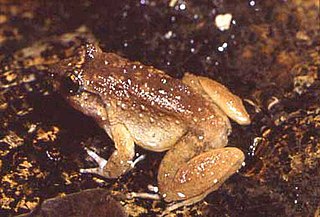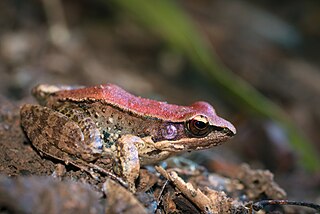
The Koh Chang frog or Koh Chang wart frog is a species of frog in the family Dicroglossidae. It is found in east Thailand and southern Cambodia. Records from Laos and Vietnam represent other species.
Amolops chunganensis is a species of frog in the family Ranidae. Its type locality, Kuatun village in Wuyishan, Fujian. It is endemic to central, southern and eastern China where it has a wide but scattered distribution ; records from Vietnam probably refer to Amolops mengyangensis.
Amolops lifanensis is a species of frog in the family Ranidae that is endemic to central Sichuan, China. It is a common species within its small range, living in and along streams in forests. It is locally threatened by dam construction.

Amolops spinapectoralis is a species of frog in the family Ranidae, the "true frogs". It is at present only known from a few locations in central Vietnam—that is, it is endemic to Vietnam—but it is likely to be found more widely in the Vietnamese Central Highlands as well as in the adjacent southeastern Laos and northeastern Cambodia. The specific name spinapectoralis is derived from Latin spina for "thorn" and pectoralis for "of the breast" and refers to the pectoral spines in adult males. Common name spinyback torrent frog has been coined for it.
Nanorana unculuanus is a species of frog in the family Dicroglossidae. It is endemic to central and southern Yunnan, China, although it is expected to have wider distribution than currently known, possibly extending into Vietnam. Its natural habitats are fast-flowing hill streams and riparian habitats in forests and grasslands, but also man-made habitats like roadside drainage ditches and ponds. It is a rare and secretive species that appears to be declining. It is currently threatened by collection for food and also by habitat loss.

Quasipaa verrucospinosa is a species of frog in the family Dicroglossidae. It is found in Laos, Vietnam, and Yunnan, China. It occurs in and around streams in hill and lower montane evergreen forests. It is believed to be relatively common, but it is threatened by collection for consumption and—presumably—habitat loss driven by logging, causing degradation of forest habitat and stream sedimentation.
Odorrana andersonii is a species of frog in the family Ranidae that is found in northeastern India, upper Myanmar, southwestern China, northern Thailand, Laos, and Vietnam; records from Laos and Vietnam may refer to another species. They are found in low tree branches and on rocks along shaded rocky streams and large rivers with boulders, in evergreen forests and agricultural areas. Breeds takes place in streams.
Odorrana margaretae is a species of frog in the family Ranidae. It is found in southern and central China and northern Vietnam.
Odorrana morafkai is a species of frogs in the family Ranidae. It is found in eastern Cambodia, southern Laos, and central Vietnam. This frog is highly unusual because it turns from its daytime green color to brown at night.

Odorrana schmackeri is a species of frog in the family Ranidae. It is endemic to China and distributed in southern and south-central China. Reports from Thailand and Vietnam require confirmation.

Raorchestes parvulus is a species of frog in the family Rhacophoridae. It is found from eastern Bangladesh east through Myanmar and Thailand to Cambodia, northern Vietnam, Laos, and Peninsular Malaysia. Its distribution might well extend into northeastern India and southern China. This species was first described by George Albert Boulenger based on seven specimens collected by Leonardo Fea from Karen Hills, Burma.

Zhangixalus feae is a species of frog in the family Rhacophoridae. It is found in southwestern Yunnan (China), northern Laos, northern and central highlands of Vietnam, northern Thailand, and Myanmar. The specific name feae honors Leonardo Fea, an Italian explorer, zoologist, and naturalist. Its natural habitats are closed-canopy evergreen rainforests, but it can adapt to human presence. Breeding takes place in streams, ponds, and paddy fields as well as holes in trees; it seems to require large trees. It is threatened by habitat loss and collecting for consumption, at least in the past.
Rhacophorus exechopygus is a species of frog in the family Rhacophoridae. It is found in the Central Highlands of Vietnam and in the adjacent Annamite Range in Laos. Its range may extend into northeastern Cambodia where suitable habitat should be present. The specific name exechopygus is derived from the Greek words exechos and pygos (=buttocks), referring to the infra-anal projection characteristic of this frog. Its common names are spinybottom tree frog and Tramlap flying tree frog.
Theloderma bicolor is a species of frog in the family Rhacophoridae, sometimes known with common name Chapa bug-eyed frog. It is found in northwestern Vietnam from the Quang Tri Province northwards and in central and southeastern Yunnan (China). Its natural habitats are subtropical or tropical moist montane forests. It is threatened by habitat loss.

Sylvirana nigrovittata, also known as the black-striped frog, black-spotted stream frog, sapgreen stream frog, etc., is a species of frog in the family Ranidae. It is found in northeastern India, Bangladesh, Nepal, southern China, Myanmar, Thailand, Cambodia, Laos, and Vietnam. The species was redelimited in 2018, and earlier literature may refer to other species; identifications from India and Bangladesh are still uncertain.
Pulchrana debussyi is a species of true frog, family Ranidae. It is endemic to Sumatra, Indonesia. It is only known from its type locality in the Batak Mountains. The holotype is now lost, and there are concerns about validity of this taxon—it might be a synonym of Sylvirana nigrovittata. Common name Battak frog has been proposed for it.
"Hylarana" montivaga, sometimes known as Langbian Plateau frog or Chantaburi stream frog, is a species of "true frog" in the family Ranidae. Its generic placement is currently unsettled. It is known from the Langbian Plateau in southern-central Vietnam; records from elsewhere refer to other species.

Sylvirana mortenseni is a species of true frog. It is found in Cambodia, Laos, and Thailand. The specific name mortenseni honours Ole Theodor Jensen Mortensen, the Danish zoologist who collected the holotype from the island of Koh Chang. Common names Mortensen's frog and Koh Chang Island frog have been proposed for it.
Hylarana spinulosa, also known as fine-spined frog and spiny frog, is a species of true frog, family Ranidae. It is endemic to Hainan, southern China. It occurs in tropical forests at elevations of 80–840 m (260–2,760 ft) above sea level. Breeding takes place in pools and slow-flowing streams.








